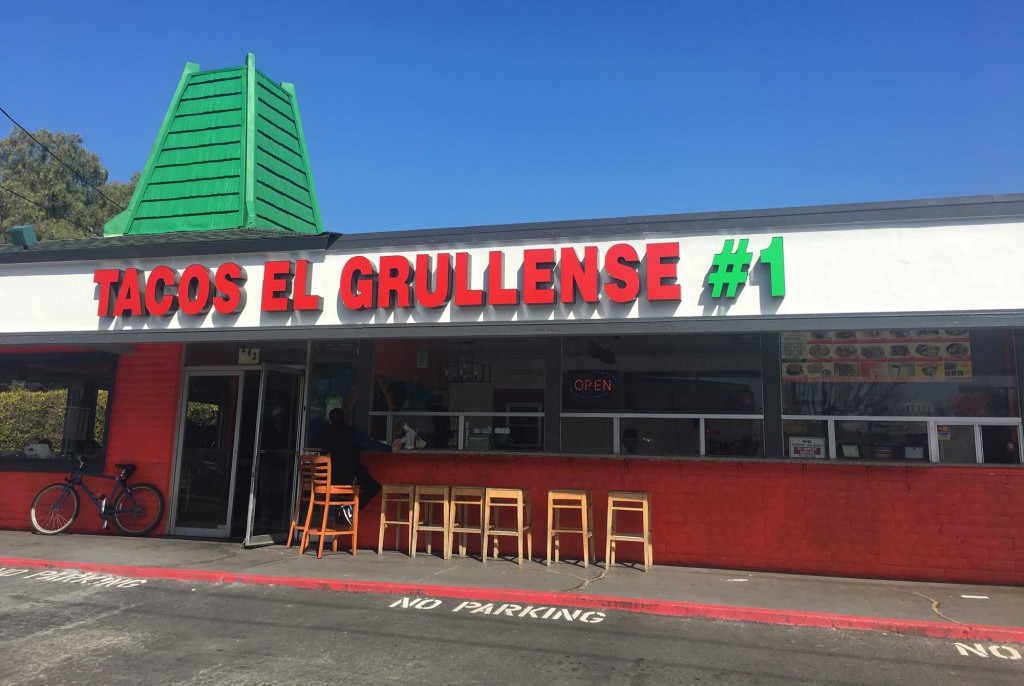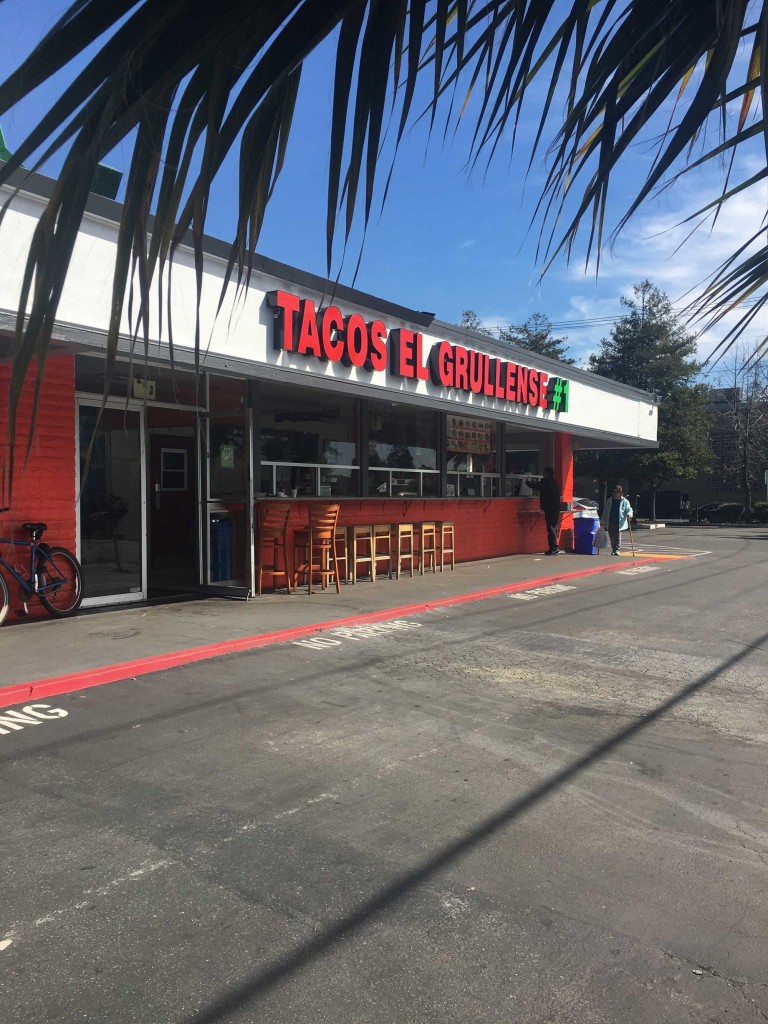It is still dark outside when the cook starts her shift at Redwood City’s Tacos El Grullense #1. She has worked at this restaurant for over 20 years, and every day it’s been the same morning routine, Mondays through Sundays, interrupted only by major holidays and sick days. Arrive by 6 a.m. Heft open the heavy back kitchen door. Tie on a bright red apron. Snugly snap a hair net over her tight bun. She works quickly and silently in the small space; the entire kitchen, renovated a little over a year ago, is made of burnished stainless steel coated with a thin layer of grease. Her job is to prepare the various foods that the restaurant will be cooking today. She does this daily, to ensure freshness.

A little before 8 a.m., a growling engine outside nearly drowns out the sound of sizzling steak on the stovetop. The planchero has arrived.
The duties of a planchero — literally, “person who operates a grill” — is to manage the stove up front, to reheat and chop up the meats that the morning crew has prepared, and to simultaneously assemble overlapping orders of tacos, burritos, flautas, quesadillas, tortas, sopes, nachos and other popular Grullense dishes. A planchero’s job requires more creativity and dexterity than meets the eye; by those who recognize it, talent at the grill is respected and venerated like any other traditional art form. A preliminary YouTube search of the term will result in hundreds of recordings of cooks, typically men, hunched over giant stovetops, single-handedly preparing meats, vegetables, breads and tortillas in tandem, their long, flat spatulas speeding across the grill.
But this is not the planchero, not yet. Instead, the patrón has arrived. David Patiño, the current owner of Tacos El Grullense, enters the building with restaurant founder Rafael Guerrero in tow.
* * *
[dropcap letter=”T”]he story of Tacos El Grullense began in 1972, when Guerrero first immigrated from Jalisco, Mexico to Los Angeles and opened up a modest food truck there. He would experiment with recipes and menu offerings to keep business going, but it quickly became apparent that any taco truck in Southern California faced pretty stiff competition. So he and his family moved up to the Bay Area, jumping from San Jose to Stockton to Hayward. They kept moving until they made it to Redwood City, where Tacos El Grullense #1 — this very same restaurant, in the very same building it’s in today — was founded.
There was a big financial draw to Redwood City at the time. Redwood City in 1987 — the year that Tacos El Grullense #1 officially opened its doors — was affordable for the young immigrant family, without much competition for an upcoming taqueria. Those qualities — low cost and competition — seem almost laughable today, given that Redwood City’s cost of living is some 77 percent higher than the national average, according to SalaryExpert, a project of the Economic Research Institute.
And as for rival business? In 2008, the San Jose Mercury News reported that there were 49 taquerias to 74,000 residents in Redwood City, the highest taqueria-to-resident ratio in California at the time, and the number has likely grown in proportion to its population growth (by 2013, the U.S. Census Bureau reported the total population of Redwood City as 80,872). Today, a drive down Middlefield Avenue finds mom-and-pop Mexican restaurants crammed together, block after block, competing for the same clientele — a bustling taqueria scene, radically different than the one the Guerreros initially encountered. Back then, Hispanic-identifying people made up 15.7 percent of Redwood City’s population, compared with 38.8 percent by 2010; the amount of Latinx-owned businesses grew accordingly. But thirty years ago, Redwood City made perfect sense for the Guerreros. They settled down, launched the business, and were soon joined by extended family members, who moved to the Bay Area and joined the Grullense franchise.
In 2017, there are more than 30 Tacos El Grullense locations in the Bay Area, all owned and operated by members of the family, an extensive network of siblings, cousins, parents and children. Patiño, for example, is married to Guerrero’s daughter.
* * *
[dropcap letter=”T”]he early lunch rush filters in. Music is blaring from the loudspeakers, upbeat banda that conjures romanticized images of Mexico. Traces of Mexico, specifically Jalisco — and more specifically, El Grullo, Jalisco, the town that gave Tacos El Grullense #1 its name — can be found everywhere, from the warm, vibrant colors of the restaurant walls, to mounted sombreros with “Jalisco” inked on the brims, to a giant mural of the Virgin Mary by the entrance. She is over ten feet tall, bedecked in bright cobalt blue, and she greets customers with a serene smile and a head tilt towards the front counter. The first few arrive, regulars who speak Spanish at ease with employees.
Adriana Sepulveda works the cash register. She smiles tentatively while she answers interview questions, keeping an eye on the door for new customers. Every answer she gives ends with a variation of the phrase, “But I’m just the cashier.”

What do you usually do here during the day-to-day?
“Stock the salsa bar, open the cash register. We get the ingredients ready for the day.”
Who tends to stop by?
“A lot of people. Families, businessmen.”
Are there any interesting stories, any notable moments on the job that come to mind?
“No. I mean, I’m just the cashier.”
It’s a bit difficult from Sepulveda’s position, standing behind the front counter and yelling out orders to the kitchen, to see the entire well-oiled machine at work. But as the cashier, Sepulveda’s role is crucial: she is the gatekeeper. Without her, the kitchen doesn’t get marching orders, and customers don’t get their food. Tacos El Grullense #1 literally wouldn’t work.
The delicate balancing act of cashier to kitchen to customer lies at the heart of Tacos El Grullense #1’s operation. When observing the staff’s interactions with one another, as they chat comfortably and react intuitively to their daily routine, it’s clear that these people have learned to depend on each other over years of shared work, language, culture and food. It’s as if the Tacos El Grullense #1 kitchen is a microcosm of Redwood City’s community — specifically, its concentrated and growing Latinx community.
It’s this same local Latinx community to which the restaurant owes much of its success. Tacos El Grullense #1 is an immigrant-founded, Latinx-owned franchise that simultaneously supports and was supported by other Latinxs in the area since its inception. There are about 14 employees at each of the two Grullense locations that Patiño’s family owns, all of them local to the Redwood City area and fluent in Spanish, often favoring it over English. When it comes to clientele, Tacos El Grullense #1 — or any of the individual Grullense locations — has never really had a formal advertising campaign, or never even really needed it. Their exposure has been via word-of-mouth and eventual success due to fiercely loyal, local Latinx customers who simply wanted a good taco and a good community and found both here.
The Grullense reputation as quick, quality taco joints established the restaurant chain as a South Bay institution early on, helping its various locations stay afloat as Silicon Valley property prices skyrocketed and other outside challenges presented themselves. The relationship Tacos El Grullense #1 has had with local communities, Latinx or otherwise, has always been constant and stable.
“If we go to any Grullenses during meals, there are people,” Patiño said. “We’re lucky for that.”
* * *
[dropcap letter=”R”]afael Guerrero has been conspicuously absent. When he finally comes out of the kitchen, he walks in a slow gait. His hair is a dusty gray, his face permanently lined with age and his shoulders are stooped forward from years of labor. He’s neatly dressed, wearing a simple buttoned-down, long-sleeved plaid shirt tucked into his jeans, with a large shiny belt buckle — relatively reserved for traditional Mexican or ranchero dress standards, but a somewhat ostentatious accessory for a Silicon Valley suburb — as the final touch to his outfit. He is a quiet and reserved man on record, declining to answer all but two questions.
One reply is about his hope that the franchise will remain a family business well into the future, a business model he took great pains to set up. The other is about the source of the success of his enterprise. It’s the last secret the Guerrero family lets me in on, the one constant that links together all the Grullense restaurants, even with their disparate menus and recipes: “La salsa.”
The response was immediate, knee-jerk.
“Tacos donde quiera hay,” Guerrero said. “Pero de la salsa no hay igual.” Tacos are everywhere. But the salsa has no equal.
The salsa — the lifeblood of Tacos El Grullense, not just restaurant #1 but of every single truck, gas station, restaurant and fast-food joint that bears the name. It’s made fresh in-house every few days, stored in huge tubs and distributed to different Grullense locations across the Peninsula. It is a red and green cash flow that enabled the Grullense empire to flourish and grow, that allowed David Patiño to comfortably open up a profitable second location in Redwood City.
“It’s the salsa,” Patiño emphatically agreed. He took a pause, and looked around the restaurant. Customers were filtering in and out, his father-in-law was joking familiarly with employees, and the air was thick with the smell of fresh cooking. The small, modest space was bursting with music, color, talk and light.
“And,” he added, “it’s the family, too. It always takes us far.”
